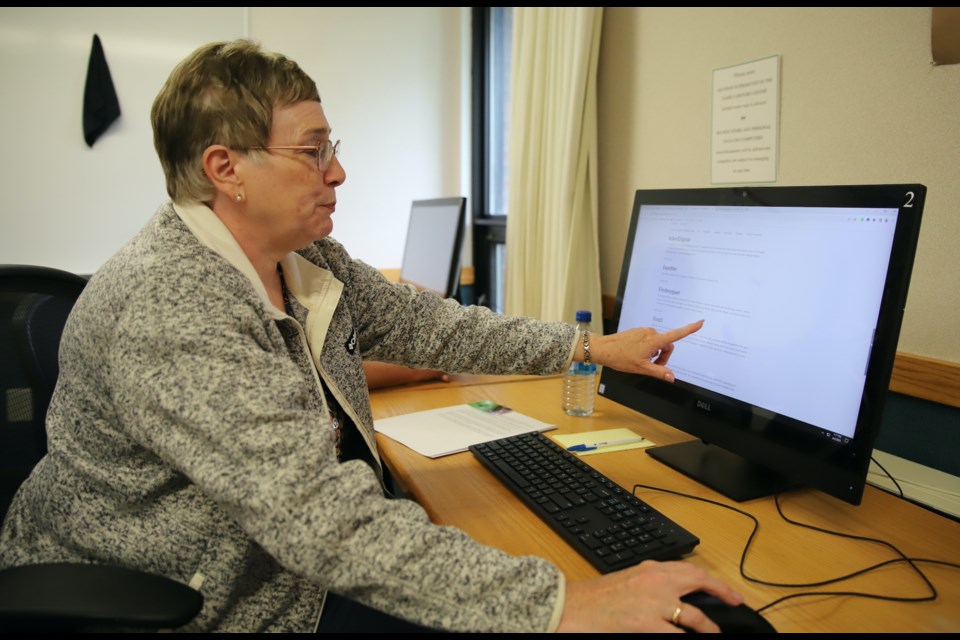OLDS — What links John F. Kennedy, Elvis Presley, Winston Churchill, Queen Victoria, Alexander Graham Bell, Edgar Allan Poe, Marilyn Monroe, Katherine Hepburn. Ameila Earhart, Helen Keller and John Lennon?
I’m related to all of them according to FamilySearch, the free genealogy (family history) service run by the Church of Jesus Christ of Latter Day Saints. (CJCLDS is known colloquially, but unofficially as the Mormans).
You too could find out who you’re related to – and if that includes famous people -- by dropping into the church, located along 57th Avenue in Olds, on certain days. Access is gained via the church's north door.
Starting Sept. 5, they’ll be open Tuesdays from 1 p.m. to 4 p.m. and from 6:30 p.m. to 8:30 p.m. If demand for their services increases, the church may add more days and/or hours.
They have a bank of computers and several volunteers trained to help people in those searches on a rotating schedule.
Kim Welton is the director of the Olds FamilySearch Centre. When I was there recently, Kathy Campbell, another trained volunteer was also there to help out.
I found out I’m not only distantly related to all the famous people listed above, but also to Welton and Campbell.
“The more people you get in there you begin to appreciate that we’re all related in one way or another,” Welton said during an interview.
Welton has learned she’s also related to Winston Churchill and Diana Spencer, the late Princess of Wales.
According to the Church of Jesus Christ of Latter Day Saints website, members of that church believe families can be together in the afterlife.
As a result, they believe it’s important to research and strengthen ties with all family members; living or dead.
“It’s important for us to identify our ancestors; know who they were, know their stories,” Welton said.
“We can draw strength from the things that they went through and the things that they overcame and accomplished in their lives to help us in our own.”
By setting up a free account through FamilySearch, people gain free access to 14 different family history websites — even 19th century British library newspapers.
There's an app for FamilySearch too, so you can search on your phone.
This past June, Library and Archives Canada released images of the 1931 census of Canada. Welton said FamilySearch is working with Ancestry to create a searchable index of that census.
However, Welton said you can’t do the searching she's talking about via an ipad or tablet. You have to do so through a laptop or Chromebook.
Campbell and Welton pointed out people can create private or public family trees. The advantage to a public one is that, by looking at it, other people you don’t even know can find out that they’re related to you and contact you.
Kim Welton
She believes she got her start when she was in her teens.
“My mom was a professional genealogist and so yeah, that kind of started there. So I’ve been at this for many years,” she said.
“I found wills fascinating. In fact, my mom had a real problem that she was struggling with and I happened to be reading a will and I said, ‘mom, what’s this,’ and asked her a little bit about it.
“I said, ‘well that means that this so-and-so is also related to that so-and-so. Could they be the same people? And they were,” she said with a laugh. "And that’s when I knew absolutely nothing.”
From there, Welton dabbled in genealogy occasionally, but didn’t begin undertaking it more frequently until about 2008.
Kathy Campbell
Campbell, who formerly lived in Innisfail, believes she “touched on” genealogy about 30 years ago, but didn’t get back to it until about 30 years later, due to family and career obligations.
She remembers how her grandmother’s generation used to keep track of the family tree.
“They would put their connections down here and then they'd write a number in the top corner and then they’d turn the page and put that number in this left corner and then they’d start on the next. They didn’t have all of this stuff,” Campell said.
“But she did as much as she could until she died, I guess.”
Campbell also has a real interest in DNA.
Campbell related one incident where, through DNA, a close friend of hers who was adopted was able to trace family members.
Campbell also found out that her father was adopted.
“(He) never spoke of it ‘till he was 80, if he even spoke of it then,” she said.
"That was like pulling teeth to get any information out of him because he didn’t have a good upbringing until he was five and then he had a good family.
“But there were seven of them. None of us knew they were adopted. And they were actually farmed out because his mother died. So all of those connections are intriguing to me.”



